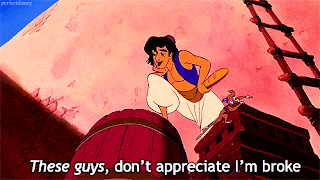Many Disney
films, such as the 1992 animated film Aladdin, are usually assumed unambiguously beneficial and appropriate for children of all ages. This is simply because of the recognition and trust that Disney has built for their brand. The movie follows the orphaned thief Aladdin on a series of adventures to fulfill his heart’s desire- marriage to Princess Jasmine. His journey of self-discovery and adventure happens simultaneously with an intertwined plotline for the ambitions of power-hungry Jafar, the advisor to the Sultan, Jasmine’s father. While Aladdin is considered an acceptable movie for all ages, its exposure to children under the age of seven should be actively mediated by parents or adult figures due to the perpetration of inaccurate gender stereotypes, a distorted moral system, and frightening images.
One of the most frightening sequences for kids is the initial appearance of the Genie. Genie is a large blue magical creature that is capable of granting wishes and taking on any appearance. Voiced by Robin Williams, he has an unorthodox appearance. He takes on a shape that is significantly larger than the main characters, and is accompanied by loud music and flashy visuals. Scenes such as this scare young children, and parents should treat their kid’s exposure to it with caution. Young kids will focus on the scary aspects, ignoring Genie’s helpful and funny demeanor.
Aladdin, the main character, is a thief who is ultimately rewarded for stealing bread and lying about who he is to everyone in the palace. Jafar is an ‘evil’ character who tries to kill Aladdin after catching him in his lie, and is punished. Children are prone to copycat behavior- imitating actions or behaviors that they see in movies. As children under the approximate of seven are so young, they fail to realize any underlying moral reasons. They simply see the ‘good’ character being rewarded for misbehavior, and the ‘evil’ character punished. Active mediation by the parent, or viewing the film and talking about it with their child, can help explain this difference to the child. For example, Aladdin steals bread in the beginning of the film because he is hungry but that does not make it acceptable. While older children will recognize this, parents will have to explain why to a young child.
Imitation of what they see on a screen is an
issue for gender stereotype portrayals as well. By making Jasmine a damsel in
distress, always needing to be rescued by Aladdin, women are shown as weak and
helpless. This is especially evident when Jafar traps helpless Jasmine in an
hourglass, requiring Aladdin to save her. Gender role expectations are formed
when children are very young. Unless corrected by parents, or adults, during
the viewing of the film, the portrayals will lower a girl’s self-esteem and
self-worth. Despite these issues for a young child’s understanding, Aladdin is a highly recommended animated film for children, as long as young children’s exposure and understanding is supplemented by parents.




Aladdin isn't rewarded for being a thief, he earns his happy ending by accepting himself for who he is
ReplyDeleteand Jasmine has more personality than other damsels in distress, she initially didn't want anything with Aladdin or Jafar